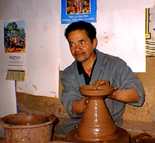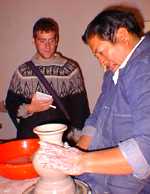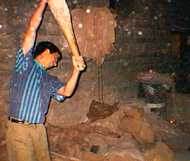|
One of the first impressions a traveler has upon reaching Cuenca is that there are a whole lot of other travelers already there. The 300,000 Cuencan population is seriously enhanced by its large influx of tourism. Although the city receives a large amount of its economic sustenance from yearly visitors, many barrios still grapple with extreme poverty. Fundacion Paul Rivet has been supporting local communities of artisans through programs that capitalize on this tourist market.

 |
| Don Pepe Alfredo at his workshop. |
In a development partnership with Esquel, Fundacion Paul Rivet provides local potters with the opportunity to expand their market and improve their financial situations. As Alexandra Kennedy, director of artisan education explains, "The potters of Cuenca are good, but they only know one style. It is the same that their fathers and grandfathers used, and they do not know how to refine their technique for more commercial success." The foundation helps potters learn both new methods and abandoned traditional styles through the use of artists in residence. They will then market the new, higher quality items to a larger market with less problems of middlemen. Also, working with groups like Esquel, the potter's connections to a commercial industry will expand.
The restoration of local pottery skills in Cuenca also coincides with the restoration of the pottery center in which ceramics will be produced. The facility providing galleries, workshops, and a store has been rebuilt in the historic building, Chaguarchimbana. This vast house was constructed from 1870 to 1906, and has been the residence of community figures, Antonio Valdiviezo, Benigno Astudillo, and Florencia Astudillo. In recent times, however, the house has become a dilapidated front for drug use and crime. By choosing this building for the project, Fundacion Paul Rivet and Esquel have not only provided a workshop, but they have saved a cultural center.

 |
| Jose at work with Ethan looking on. |
With 60% of the workshop finished, Chaguarchimbana already offers instruction to local potters. Local artisans come in the evening after work to study with the workshop's accomplished teachers. Ethan and I had the opportunity to visit the workshop and meet with one of the master potters, Jose Cumbe. In a matter of minutes he had demonstrated his trade by sculpting several different bowls from a shapeless block of clay. He explained to us, "What you need to make pots is simply creativity and a little skill." The little skill part was an obvious exaggeration (I spent two years of high school slaving over a pottery wheel before I could make a saucer!)


 |
| Jose crushing earth into clay with an old technique that uses a huge club called a palo |
After a short lesson with Jose, Ethan and I then visited personal studios where artisans apply the skills they learn at the workshop. We met Don Pepe Alfredo, who has been spinning bowls for 35 years. He runs his pottery shop, called Ceramics de Alfredo, with the help of his entire family. His sons help throw and fire the bowls and his wife and daughters help sell the finished products. While the men are productive, they operate under inadequate conditions. For example, they use a cumbersome Palo (a huge heavy bat) to prepare clay. Now with the aid of modern machines at the workshop however, not only will the men's skills increase, but their efficiency will double as well.
|
|




